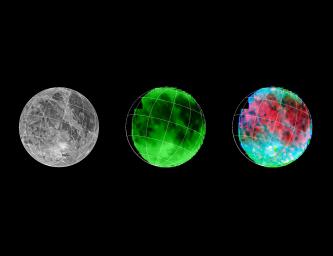skip to navigation

|
NIMS Ganymede Surface Map
- Click the image above for a larger view
- Full-Res JPEG (1950 x 1500) (170.1 kB)
- Full-Res TIFF (1950 x 1500) (1.2 MB)
Caption:
Galileo has eyes that can see more than ours can. By looking at what we call the infrared wavelengths, the NIMS (Near Infrared Mapping Spectrometer) instrument can determine what type and size of material is on the surface of a moon. Here, 3 images of Ganymede are shown.
Left: Voyager's camera.
Middle: NIMS, showing water ice on the surface. Dark is less water, bright is more.
Right: NIMS, showing the locations of minerals in red, and the size of ice grains in shades of blue.
Background Info:
This image and other images and data received from Galileo are posted on the World Wide Web, on the Galileo mission home page at http://galileo.jpl.nasa.gov.
Cataloging Keywords:
| Name | Value | Additional Values |
|---|---|---|
| Target | Ganymede | |
| System | Jupiter | |
| Target Type | Satellite | |
| Mission | Galileo | Voyager |
| Instrument Host | Galileo Orbiter | |
| Host Type | Orbiter | Flyby Spacecraft |
| Instrument | Near-Infrared Mapping Spectrometer (NIMS) | |
| Detector | ||
| Extra Keywords | Color, Infrared, Map, Water | |
| Acquisition Date | ||
| Release Date | 1998-03-26 | |
| Date in Caption | ||
| Image Credit | NASA/JPL | |
| Source | photojournal.jpl.nasa.gov/catalog/PIA00500 | |
| Identifier | PIA00500 | |
